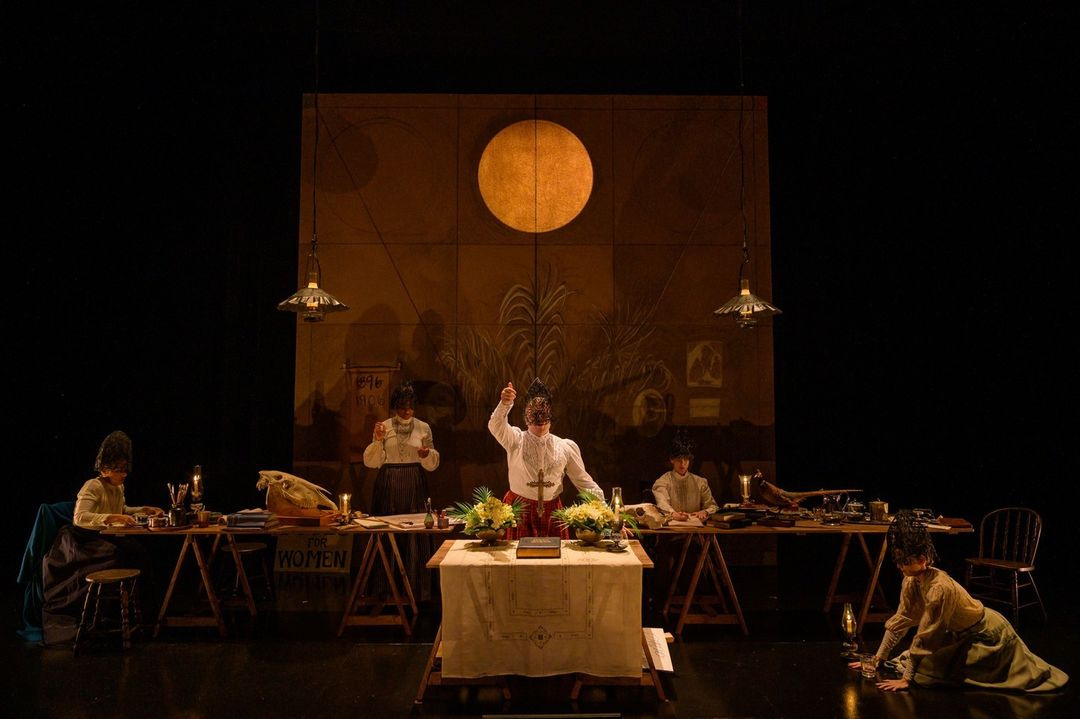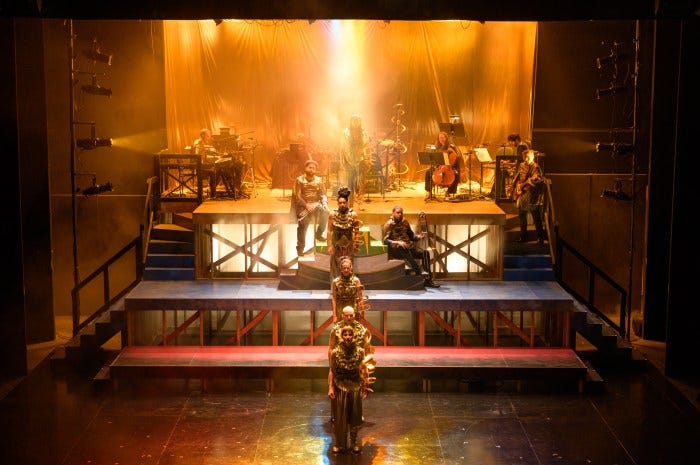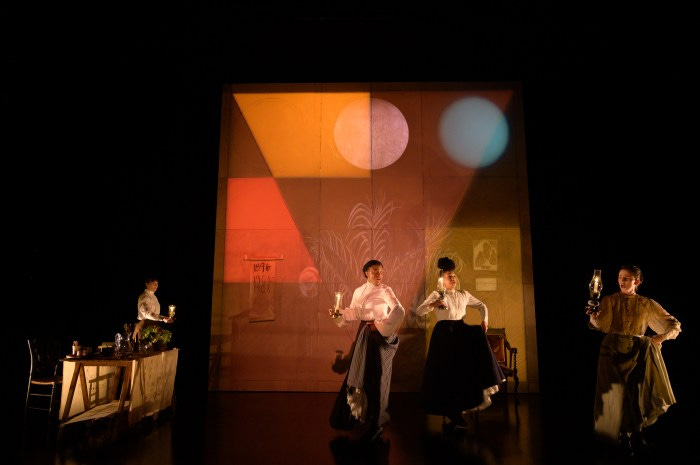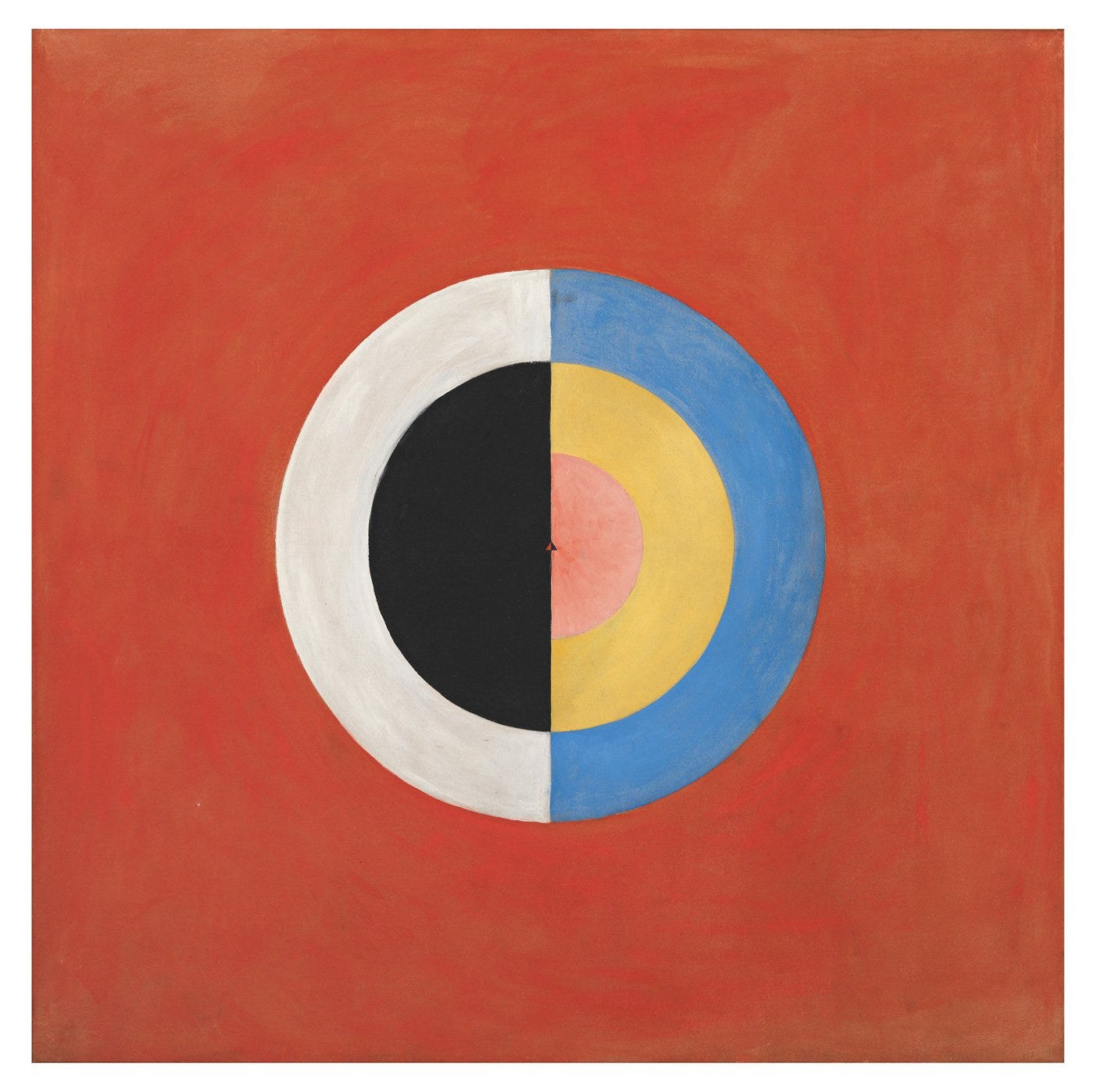Hilma at The Wilma
A contemporary "opera" indistinguishable from a parody of a contemporary musical
Hilma
A Contemporary Opera
Words by Kate Scelsa, Music by Robert M Johanson
Directed by Morgan Green
at the Wilma Theater, co-produced with New Georges, through June 23, streaming video available June 24 through July 21
Not Recommended1
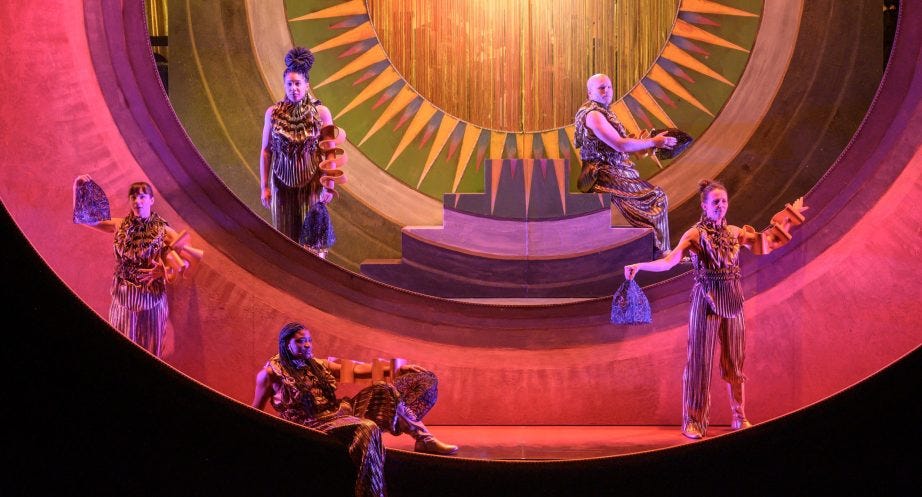
Hilma has all the trappings of a hit, or if not a hit, then a striking piece of contemporary art. It has its own making-of docu-series, as if the artists and the producers, veterans of the contemporary theater scene with awards to match (Wilma co-AD and director Morgan Green of New Saloon, librettist Kate Scelsa of Elevator Repair Service, composer/performer Robert M Johanson of Nature Theater of Oklahoma, actors Sarah Gilko and Brrett Ashley Robinson of The Wilma’s HotHouse company, Kristen Sieh of The TEAM, and Evan Spigelman whose credits include Taylor Mac’s 24 Decade History of Popular Music), know they are doing an Important Work about an Important Artist. This is maybe part of the problem, the show is so sure of its own importance, of how interesting it's subject matter, of its self-seriousness, that it seems to not notice that not only is the show boring, but that it has descended into self-parody.
The nearly completely sung-through musical2 is structured in three acts.
The first is a fairly conventional narrative musical, covering 1896 to 1912. We’re shown parts of af Klint’s life that directly pertain to the creation of her now-famous body of work, including her membership in Der Fem (The Five), a group of five women with a shared interest in Theosophy. The show doesn’t get far into what, exactly, Theosophy is, or why we should care about it besides some connection to the spiritual world and its influence on af Klint. Nor does it explore what Der Fem are up to, other than spiritualist seances. At best, Wilma’s Hilma’s Hilma is a visionary spiritualist with an incredible connection to the spirit world, at worst, she seems crazy. Especially when the Master Amaliel bursts through a door in the wall and begins telling Hilma to paint in rose pink.
There's barely a mention of af Klint’s life before or after this period, save for the key detail that she finished the body of work in the years following. The show is not so much about Hilma af Klint, then, as it is about the 2018 Guggenheim show and the reaction to it, a narrowing of scope that doesn't really help things—here is a person who lived a whole life, and we get the tiniest slice of it. At least the show avoids other pitfalls of artist bio-shows (see also: the recently closed Broadway-bomb Lempicka, directed by The TEAM’s Rachel Chavkin), but it mistakes itself as being as important as its 2018 object of study.
Act 1 has little to no drama. It teases some in a scene where Hilma tries to persuade Anna (J Molière, who kept going flat), who it’s implied is Hilma’s lover, to join her in creative partnership. Wash and repeat as they try to summon drama from such minor moments within the group of Theosophists. The only real moments of tension come during an admittedly exaggerated encounter with Rudolf Steiner (Johanson), which teases the majesty of af Klint’s paintings, glowing on the other side of a doorway. Both Johanson and Sieh are quite good here, but the scene is just strange. For example, Steiner drops his coat on the floor, and things only get weirder when Anna enters and the scene half-plays as-if she interrupted Steiner making a pass at Hilma. After viewing the new paintings and being solicited for his most honest opinion, Steiner states that, “the people will find it pretentious, reject it as precious.” Everyone involved with this production seems to have missed that this criticism applies to the play.
Besides all that, and lacking memorable songs, the mix is bad. The show often just doesn’t sound good. Half the audience left at the interval. At least three people walked out within the first half hour.

Act Two delivers a welcome break into “the astral plane,” with a marvelous reveal of an upstage set, previously teased at, built as a 3-dimensional af Klint painting. Weirdly, all the flats seem a little too short to fully cover up the background and create the picture the design seems after, even from my seat in the dead-center of the house. Here the cast are in fun and cheesy gold costumes, evoking the futurism of a century ago, but these images are by now well worn, and as they sing about spiritualism and do dance moves that include “stirring a big pot” and “shaking my hands next to my head” (the first act’s choreography is even more boring, but not as funny), it’s less Dada and more low-rent 70’s sci fi. The flats have all been flown out revealing the 8-person band in af Klint paintings rendered as robes, playing acid-y jazz with lyrics about the universe seeing itself. And, surprise, the flats are wired with LED lights! It’s a knock-off Sun Ra Arkestra concert. If those 70’s vibes aren’t enough, you may be satisfied by the disco ball that appears above the audience. It’s all very “Theosophy! The Musical!”
Act Three follows immediately, staged as a talk-back and described as “here, tonight” complete with six chairs for the cast and a pair of microphones set in front of the curtain. The actors enter in street clothes, one at a time, and it seemed to trick some audience members—they all got a touch of entrance applause. I’ve written the stage direction, “here, in the theater” many times but my jaw dropped in disbelief when the first two actors to come on started talking about the experience of the “Paintings for the Future” exhibit. It’s just too pretentious, bordering on an insult to the audience, exemplified by the convention of actors needing and passing the mic—when the actors are all fully mic’d—which was dropped without ceremony later in the scene (why adopt the convention at all?). It made me wonder what we were watching, not as if we were seeing a talkback, what was the origin of this text: is it devised? Is it written? Is it sourced from other accounts? Is it verbatim from part of a rehearsal? Scelsa is the only credited writer, as librettist (Jackie Tileston, a UPenn professor of painting, is dramaturg). The actors are only credited as their characters in the first act. Throw us a bone here. (Research reveals that act 3 is transcribed audio of Scelsa “ranting.” Her word.)
Despite pretension, it’s the most successful scene in the play. This makes sense, it’s here where the show is most in the wheelhouse of both Elevator Repair Service and Nature Theater of Oklahoma, the latter of whom’s 9-part Life and Times, which Johanson composed the music for, is a verbatim sung-through staging of a recorded personal narrative, complete with ums and uhs. The scene even gets cooking, up until the very end where the curtain rises again and it attempts to tie all three acts together. If only the whole show was like this. Though, if you were writing a parody of contemporary theater, you might end it with such a meta-theatrical gesture.
Short of the final numbers, each of the three acts could stand on its own as a one act play. What might a more radical approach that integrated these acts together have accomplished? And there's little missteps along the way, like when Anna first walks on, late to the Der Fem meeting because she was at a suffragette rally—which is a throwaway moment except for one line later, when Hilma says she is not one of Anna’s causes. The “Votes for Women!” sign she carries does not help the “parody of a feminist musical” vibes. An actual parody would be more fun.
After all that, I was embarrassed for the actor who was tasked with making a fundraising appeal at the curtain call.
Nothing here approaches the majesty or wonder of an af Klint painting, and I think there’s a certain disrespect to the legacy in reducing the astral plane to whatever that was. We’re at such a historical remove from late 19th century esotericism, of the currents that bred such an interest in an American spiritualist movement like Theosophy (I wonder what the folks at the United Lodge of Theosophists on Walnut St would think), that these are difficult to relate to. Hilma seems to look back on these movements fondly, or at least uncritically, with its repetition of “as above, so below” and mentions of astrology in the third act. It affirms the popular perception of af Klint as an outsider artist, a weirdo mystic. A century ago, people were making sincere and often out-there efforts to understand the rapid emergence of new technology and new media. The spread of the telegraph corresponds with the rise in the popularity of spiritualism—both are media that collapse distances, traversing in an instant what previously required days, weeks, or an eternity.
Today, though, despite the scientific understanding that there is no astrophysical connection between the above and the below, astrology is popular (nevermind that sun- and star-sign astrology, as we know it today, descends not from traditions of ancient mystics reading the skies, but from newspaper horoscopes that gained popularity in the 1930s), even becoming part of queer culture. Alongside a broader rise in pseudo-scientific thinking this should be troubling. I think in this context, there’s a reading of Hilma here as the portrait of both a visionary artist and also pseudo-scientific wingnut, down to her unwavering belief in a temple for her paintings (which the show seems to suggest borders on delusion, as it never gets into how large the Theosophic movement was, regardless of how her paintings would have theoretically been received). I don’t think this is what Scelsa and Green are trying to get at, but Hilma’s Hilma is a bourgeois painter—there are no class politics in the play at all—and the odds are more than zero that someone like her today would be preaching on the horror of vaccines. This is all very rich territory, but it’s not explored. As the play admits, there’s just so much we don’t know about her life (af Klint left for posterity her artworks and notebooks, not diaries or correspondence). Instead, there’s a too-simple narrative of the patriarchy—Steiner—keeping the woman down; a historicization of her as oh-so-queer, complete with draw a line from her occultism to the actors being Virgos or whatever. This is presentism, putting our biases of the present onto the past, and the admission of “I want him to be the villain!” in the third act doesn’t do much to counter it. But the real past is almost always more interesting than our common sense ideas about it. For example, mediumship was not without controversy within theosophy. That someone both believed they’re channeling the spirits and was a visionary artist, as af Klint was, is fascinating material enough.
If the show took itself less seriously, if it seemed in on the joke, I might recommend it. But it would be rude to tell you to sit through the wearisome first half, get stoned at the intermission, and enjoy the so-bad-it’s-good vibes of the astral plane, man. If the first half were a little more like that and less on the just plain bad side, maybe I’d tell you to go get blazed and laugh it up, and to marvel at the reveal of the colors and the lights. Embarrassment be damned, the theater has to bring in money.
I would add “with redeeming qualities,” here, but the redeeming qualities come so late in the show and after so much that has none, that the positive qualities are moot.
The show bills itself as a contemporary opera, following Nature Theater of Oklahoma’s work, but there is nothing meaningfully operatic here—the traditions and personnel drawn on here all come from theater. This is a bummer, because contemporary music would suit Hilma af Klint’s work, matching the music of the future with the paintings for the future. Not even the promise of the ambient synth hum at the preshow is fulfilled, in neither pacing nor sound, and much of the show sounds like a standard contemporary musical (why do musicals sound like that?)
There's something else that work In the misuse of genre, which I think says something about the field and is even a little insidious. There's an arrogance at work here, claiming participation in a field run by people who should be our genial colleagues in the performing arts, indeed, are collaborators for some contemporary theater makers. Instead, the claim suggests an ignorance of, or worse, a lack of interest in, what's going on among our contemporaries. Our disciplines and traditions are so important in the arts, whether we're carrying them on proudly or making radical breaks. How many of us can trace the number of steps we’re removed from famous master teachers? Why would we claim those of our peers? How dare we.




